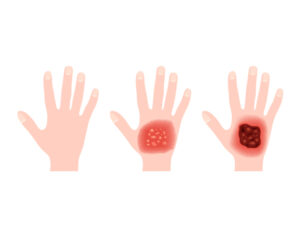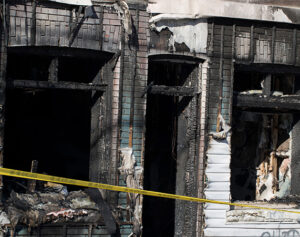People suffer severe burn injuries from contact with flames, scalding liquids, electrical current, radiation and exposure to industrial chemicals. Serious burn injuries can cause intense pain and can leave disfiguring scars. Burn victims who inhale smoke may experience breathing difficulties. A burn injury survivor may require a lengthy stay in a hospital or specialized burn treatment center, need multiple surgeries and miss months of work or school.
At David Blackwell Law, our skilled and compassionate legal team in Indian Land and Lancaster have extensive experience helping burn injury victims seek compensation when another’s negligence caused the accident resulting in a burn. Our law firm concentrates on representing people for the right reasons and working to make our community a safer place to live. You should not be saddled with medical bills if someone else was responsible for your burn injury.
We seek to offer encouragement to our clients that there is a path forward after a serious injury, with the guidance of a caring attorney. We represent burn injury patients and their families in Lancaster, Indian Land, Heath Springs, Kershaw, Buford, Van Wyck, Fort Mill, and communities and throughout South Carolina. If you have a valid burn injury claim, we will fight to take care of you, no matter the expense to us. Call us for a free consultation to explore your legal options with a burn injury attorney. Contact attorney David Blackwell to find out how we may help.
What Are Common Ways Burn Injuries Occur?
There are numerous types of burn injuries. Open flames, scalding liquids, breathing smoke, electrical shock or defective products such as an e-cigarette explosion can all cause serious burn injuries.
Thermal burns are the most common type. Injuries caused by contact with open flames represent a sizable portion of burn injuries to adults. A car may explode into flames after a crash. Scalding liquids such as boiling water and hot beverages may produce thermal burns. A young child may pull a pot or kettle of boiling liquid off a stove. Scalds, in fact, are the leading cause of burn injuries to young children and elderly adults.
Certain chemicals such as strong acids and bases can cause caustic burns if they come into direct contact with the eyes or skin. An industrial accident or workplace accident may involve a chemical burn. Common products associated with chemical burns include ammonia, car battery acid, pool chlorination chemicals and bleach. The symptoms of a chemical burn will depend on the strength of the chemical and amount of time the chemical remained in contact with the skin. A severe chemical burn may cause infection, tissue damage, scarring, disfigurement, and limb loss and require specialized treatment at a burn center hospital.
Electrical burns are caused by electricity passing through the body. These burns may occur from contact with household electricity, broken wiring, exposed parts of electrical appliances, ungrounded power tools, high voltage power lines, stun guns or lightning. If the electrical current passes along the skin surface, it can cause extensive second-degree burns. Even if the electrical burn wound appears small, you should seek a medical examination. An electrical burn may cause extensive damage to internal tissue and organs, even though it appears minor on the skin surface. Certain types of jobs such as those of utility workers and electricians involve workplace exposure to electrical current.
Radiation burns cause damage to the skin. The most common type of radiation burn is sunburn. Tanning booths and sun lamps can cause radiation burn. Prolonged exposure to x-rays during medical tests can result in radiation burns. Radiation treatment for cancer may cause burns, resulting in blisters or ulcers.
How Severe is Your Burn Injury?
 Doctors categorize the severity of a burn injury based on the extent of damage to the skin and underlying tissue. The more extensive the damage to the body and the deeper the damage, the more severe the burn.
Doctors categorize the severity of a burn injury based on the extent of damage to the skin and underlying tissue. The more extensive the damage to the body and the deeper the damage, the more severe the burn.
A severe burn is a burn that covers more than a quarter of the body’s surface or a burn affecting the eyes, face, hands, feet or genital area, according to the American Burn Association.
- First-Degree Burns — First-degree burns can cause pain, swelling and reddening of the outer layer of skin. But they generally do not cause lasting damage. Sunburn is a common first-degree burn. Drinking extra water when sunburned can help keep you from getting dehydrated. First-degree burns generally can be treated with home first aid by immersing the burn in cool tap water, then covering it with petroleum jelly and covering with a sterile bandage.
- Second-Degree Burns — Second-degree burns penetrate deeper and cause damage to the under layer of skin —the dermis—as well as the outer skin layer—the epidermis. They cause blistering and wet skin. They are known as partial thickness burns. Deeper second-degree burns appear white and can leave scars. If you suffer a second-degree burn to the face, hands, feet, groin, or around a joint, immediate medical treatment is needed. Doctors will treat it as a major burn. A patient with second-degree burns covering more than 20 percent of the body may be referred to a burn unit for specialized treatment.
- Third-Degree Burns — Third-degree burns, which are known as full-thickness burns, damage all the layers of skin and the deeper tissue beneath the skin. Third-degree burns can be life-threatening and are a medical emergency. The skin area damaged by a third-degree burn may appear leathery and dry and be discolored. The victim may not feel pain because of the destruction of nerve endings. Patients with third-degree burns will require extensive medical treatment, often including skin grafts. A patient with third-degree burns covering more than 5 percent of the body may be referred to a burn unit for specialized treatment.
Most patients treated at burn centers survive. However, many survivors will have serious scarring and lifelong disabilities and will need all the financial support possible.

 An accident victim who has suffered serious second- or third-degree burns will require extensive medical care and may face a lengthy recovery. The treatment may involve multiple staged operations and skin grafts to close wounds, rebuild damaged areas and address scarring. The burn victim may have months of physical therapy. A serious burn survivor will have high medical bills and will need to make use of all financial resources available.
An accident victim who has suffered serious second- or third-degree burns will require extensive medical care and may face a lengthy recovery. The treatment may involve multiple staged operations and skin grafts to close wounds, rebuild damaged areas and address scarring. The burn victim may have months of physical therapy. A serious burn survivor will have high medical bills and will need to make use of all financial resources available.